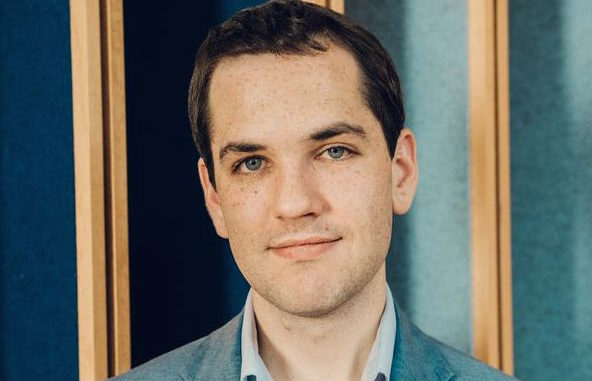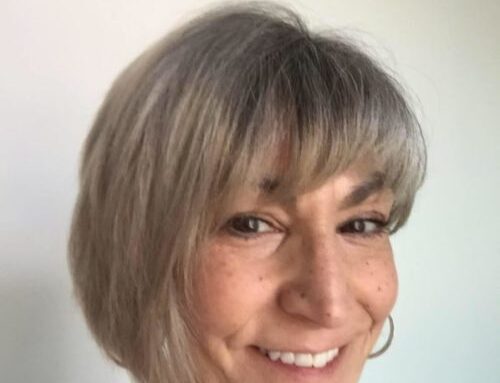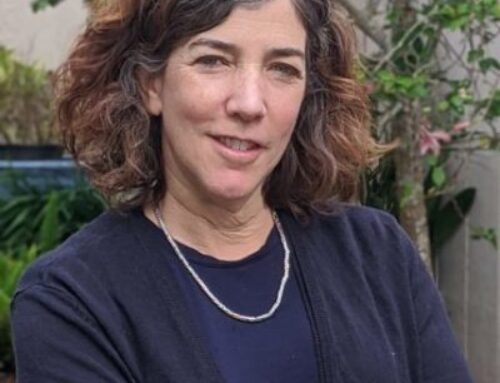Good People for the Resistance is a twice-monthly interview with people who give me hope during these dark times. Today, meet Ezra Levin, co-founder of Indivisible, the nationwide, pre-eminent anti-Trump resistance organization.
In December, 2016, shortly after the election, Ezra and his wife Leah Greenberg wrote the Indivisible Guide, a Google Doc manual on how to create a grassroots movement to resist the GOP’s rule. As former Congressional staffers, Levin and Greenberg had witnessed the Tea Party’s rise, and its ability to stall and sometimes block Obama’s agenda. They knew that progressives had much to learn from the Tea Party’s tactics. With so many of us desperate to do something, the Indivisible Guide quickly went viral.
Remember all of those people showing up to challenge legislators at Town Halls, and flooding Congressional phone lines with calls? That was the work of Indivisible— now a national organization that supports 5,000+ Indivisible chapters across the U.S., with at least one chapter in every Congressional district. This year, co-executive directors Levin and Greenberg made Time Magazine’s 100 Most Influential Leaders.
What’s Indivisible’s plan to beat Trump and save Democracy? Read on…
Q: You’ve been called the “liberal version of the Tea Party.” Do you agree with this?
Leah and I were on Capitol Hill during the rise of the Tea Party. We saw their power early on. When you’re not in the White House or control Congress, you need to play defense. That’s what they did and that’s what we did. The Tea Party saw the value of constituent power; they got people to focus on their elected representatives, and it was a smart strategy.
Eventually, the Tea Party was taken over by elite GOP donors with reactionary goals, like the Koch brothers. There are big differences between Indivisible and the Tea Party: we are non-violent, we are not racist, we treat everyone with respect, and we care about the facts. And we remain a grassroots, people-powered organization.
Q: To what do you attribute Indivisible’s rapid growth and success?
From the start, we were very careful to make the local Indivisible groups the leaders of our movement. It was not going to become the Leah and Ezra operation. We exist to support local groups across the country. Indivisible provides resources on what local groups need to be effective; content on issues like Immigration, Climate, Health Care, as well as practical guides on how to run a meeting and what to say to your Member of Congress. Each group decides what it wants to work on.
We now have over 5,000 groups; we’re in every Congressional district in the country. Indivisible groups vary wildly in terms of how big they are, who they are, and what they do. Some are political powerhouses with hundreds or thousands of people, and they have the Governor on speed dial. Some are a couple of people who started out as a book group. We are a movement that is owned at the local level. If someone raises their hand in a community and says “we will be Indivisible,” then they become Indivisible. That’s all it takes.
Q: In August 2017, shortly after you got started, you were quoted in Rolling Stone saying, “We don’t view ourselves as an arm of the Democratic Party.” Why did you make that decision? What’s your relationship with the Party now?
The time when Leah and I were most scared came about a week after Trump was elected. A future Trump appointee was talking about the Japanese who were interned in the U.S. during WWII; he said, “this is what we’ll do with the Muslims.” At the same time, Senate Minority Leader Chuck Schumer was saying he wanted to cut deals with Trump on issues like infrastructure. For us this was a terrifying moment. We thought, “Oh great, there will be no potholes on the roads to American concentration camps.” We decided this was no time to be cutting deals with fascists – we had to convince our allies to fight hard against them, to say no, that this is not normal. We are not captured by the Democratic Party. Sometimes we work with them, sometimes not.
Q: What do you think is the key to the Democrats ousting Trump in 2020?
The issue is not just what happens 2020. The fact is that Trump is a terrible symptom of a long-term trend in the GOP party. They are anti-democratic and pro-inequality. The question we are now facing is what kind of future will we build in 2021? We need to look beyond 2020.
Trump’s vision is out there. We know what he will run on – xenophobia, anti-immigrant, racism, fear-mongering. If the Democrats try to convince Trump supporters they should vote for a Democrat, we will lose. The choice cannot be Trump or Trump-lite. The Democrats have to rally around an alternative vision of America and of our future. Warren, Harris and Buttigieg are all talking about their vision – we can’t just go back to some mythological past.
It will not be enough to beat Trump. The Senate is a threat to all we have to accomplish. McConnell has said that he is the “grim reaper” of progressive legislation. If we don’t net three seats in the Senate then we can’t get a budget, the ACA, forget about fighting gun violence, none of what we want to happen will happen. It’s not enough for us to take down Trump. We need to get the Senate and keep the House.
Q: This blog is called Good News from the Resistance and you are starting to depress me. Is there a chance we can take the Senate?
If the election were held today we would not, but we have time to build it out. There is certainly an opportunity. This election will be a referendum on Trump, and polls in Iowa and North Carolina show he is not doing well. And where he is not doing well, we can take seats – places like Colorado, Maine, and Arizona. We were worried about Susan Collins, but as result of her partnering her with Trump and McConnell, her approval ratings are now, for first time ever, under water. We need to think about Pennsylvania, Wisconsin, Florida, Nebraska and Texas. We can do this. We could conceivably flip the Senate. This is what motivates us.
Q:What’s it like for you and your spouse Leah to work together so closely, during such intense times?
In a very short amount of time, we built this new thing and learned how to do it together. Now, we are co-directors. Frankly, I don’t understand how anyone is an executive director alone, given all of the internal and external responsibilities; it’s seems like an unreasonable amount of work to put on any one person. And I certainly don’t know how anyone is co-executive director with someone they are not married to, given the amount of trust you need to constantly say we are 100% rowing in same direction.
We tried to address work-life balance and made rules like, “we won’t talk about Indivisible while we are walking the dog.” That didn’t work.
Leah and I just finished writing a book. She is an early riser and I am a late worker. So I would work until 1-2 a.m. and she would get up at 5 a.m. and work on my draft. The reality is that we are both living and breathing Indivisible all of the time.
Q: How do you get new people engaged, to join the Indivisible movement?
Most of the time, most people are not paying attention. We have to recognize that. But there are times when people lift their heads up. Trump attacking health care, children being caged at the border, abortion bans being enacted. At these moments people who are never engaged start paying attention. This is what we call a “movement moment.” A person’s first response is often powerlessness. It is in this moment that a local Indivisible group in their area will plan a day of action, give people a way to fight back. This is the time for us to get them to a meeting, have them participate in an action, then get them to the next meeting. This way, we are continually recruiting new members, giving people something to do about the atrocity.
Q: How many hours a night do you sleep?
Now, about 6. There was a time in early 2017 when Indivisible was taking off, we were all volunteers, trying to keep the organization together with duct tape and popsicle sticks. We were always working 17 hour days. Friends started bringing us meals to make sure we were eating. I lost 30 pounds. Thankfully, we are not there anymore.
At this point our big challenge is not to burn out staff. And at the same time fight for the soul of American democracy. So how do we ensure people can sustain the work until 2021? We recognize the flash moments where we have to put in the effort to fight.
Q: Tell me about your book. What’s it about?
It’s called Indivisible: A Blueprint for America After Trump. It’s about the future. We tells stories that came out of the Indivisible movement, and draw out 19 specific lessons; how Indivisible groups built their own local pressure to get progressives elected, how they built the Big Blue Wave in 2018. It’s immediately applicable for 2020, and in 2021 after the election, as we fight to rebuild America.
In the book, we talk about what America looks like post-Trump, and how can we usher in this vision. In 1998 the president of the right-wing Heritage Foundation said, “We win when fewer people vote.” The GOP knows that representative democracy will not allow them to implement their agenda. This is what we are fighting for – to save democracy.
Q: If Trump invited you to the White House, would you go? Would you shake his hand?
I don’t think I’d go. There is a real danger of legitimizing fascism and authoritarianism and the racism he exhibits. You don’t always extend a hand and bargain when other side is screaming at top at their lungs let’s burn the whole thing down. Most of what I’ve seen from people I know who meet with him is that they get his gunk on them. So no, I would not shake his hand. There are lines we can’t cross and sometimes that means not engaging with the adversary.
Q: Who’s your dream 2020 presidential team?
There are currently more than 20 candidates running, and what we want to see is for them to “out-democracy” one another. We want them to say, “this is my vision for democracy after Trump is gone.” Rachel Maddow said we should be voting our hearts in the primary and heads in the general. Whoever wins the nomination, I will spend the 16 weeks before the general election making sure they are the next president and vice president of the United States.











Awesome profile – great to hear the direction this organization is taking. I love the Good People posts!